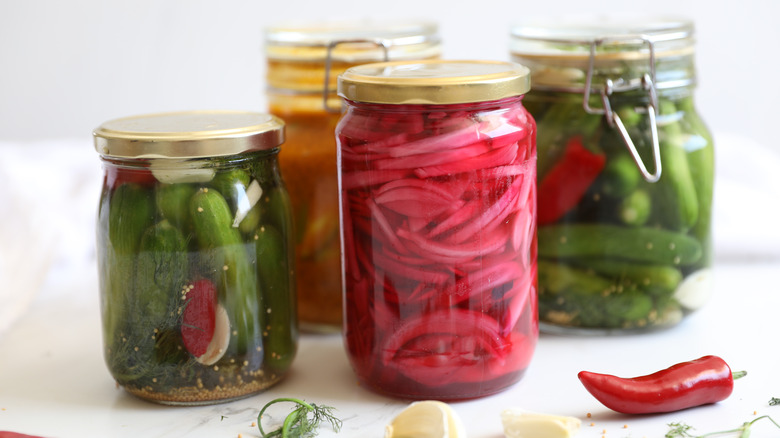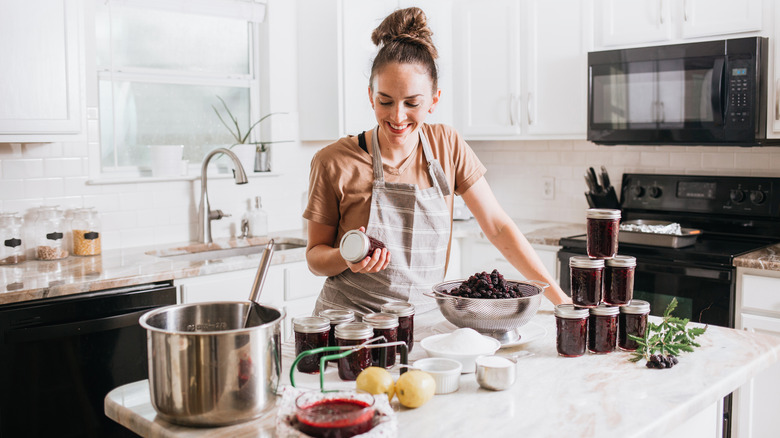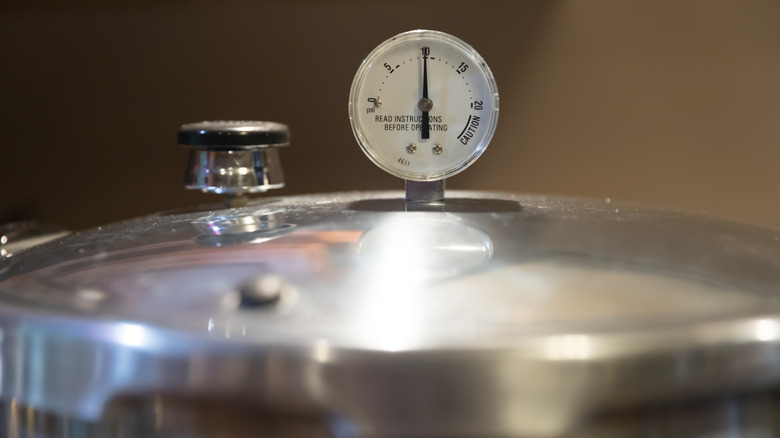What's The Difference Between Water Bath Canning And Pressure Canning?
Canning food is a type of food preservation that has been utilized for hundreds of years, although it's still quite young in comparison to other methods such as salting and drying, per The National Center for Home Food Preservation. At its core, canning preserves food that has been placed in glass jars and heated to the point where harmful bacteria is killed, allowing the jars to be stored at room temperature for a prolonged period of time. Gardeners often can their excess bounty to ensure nothing they've grown goes to waste, while people who live off the beaten path or in locales with long winters might can food to avoid a food shortage in extreme weather. Others advocate canning because it's cost efficient and eco-friendly.
Any way you look at it, canning is always a good idea, but it does take work, and — most importantly — food safety knowledge. The two types of canning methods are pressure canning and water bath canning (also known as hot water canning), and the two cannot necessarily be substituted for each other (via Home Stratosphere). Truth be told, processing foods with the wrong type of canning can lead to serious illness. But fear not, young canner, because knowing when to use one method or the other is quite simple.
Water bath canning
According to Home Stratosphere, water bath canning happens when covered jars of food are fully submerged into a large pot of boiling water and heated for a set length of time. Some basic equipment needed for this method is a large, deep stockpot, a metal rack that sits at the bottom of the pot so the jars do not directly touch the bottom, and a jar lifter, which is a special set of tongs to grab the jars out of the pot (via The Old Farmer's Almanac). Special canning jars and lids are also required and must be washed and sterilized before food is added to them.
Each canning recipe gives you the precise directions and amount of time the jars of food should be boiled for. Once the boiling time is up, jars are left in the water for a short period of time and then lifted out of the water and left to cool untouched until the lids are sealed. This is where you'll usually hear the characteristic "pop" sound the lid gives off when it is sealed successfully.
The only types of food that should be processed in a water bath are fruits and vegetables that are high in acidity. This includes tomatoes, most fruits (both whole and in jam form), and pickled vegetables. The acid that naturally occurs in these foods, along with the heat of the boiling water, will preserve these types of food safely.
Pressure canning
Pressure canning, unfortunately, has garnered a scary reputation. Old tales of exploding pressure canners discouraged many people from utilizing the method altogether. But Better Homes & Gardens notes that many improvements and safety measures have been implemented since those early canners, and you can rest assured that modern canners are safe. Not to be confused with pressure cookers, pressure canners are pots that only get filled with two to three inches of water. They have locking lids and a dial or gauge that is used to regulate steam pressure. It is this steam pressure which produces the extreme heat (240 degrees Fahrenheit) that kills harmful bacteria. Like water bath canning, foods are placed into sterilized jars, sealed, and placed inside the canner on a rack before processing.
Michigan State University notes that pressure canning is the only safe method you can use to preserve foods with low acidity. This includes any unpickled vegetable, soups and stocks, meats, seafood, and poultry (via The Old Farmer's Almanac). Without proper processing, these foods are vulnerable to the bacteria C. botulinum, which causes botulism, a potentially fatal illness.
If any jar has a lid that has not sealed properly after processing and cooling, you don't need to throw it away, but you should place it in the refrigerator and eat the contents right away. This is true with water bath canning, too. Once you get the hang of whatever method of canning you choose, you'll be enjoying your favorite foods year round.


